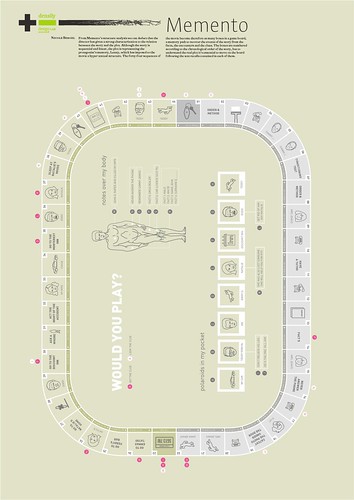A set of graphic visualizzation about the movie Memento by Christopher Nolan (2000).
The film’s events unfold in two separate, alternating narratives—one in color, and the other in black and white. Leonard’s investigation is depicted in five-minute color sequences that are in reverse chronological order. As each scene begins, Leonard has just lost his recent memories, leaving him unaware of where he is or what he was doing. The scene ends just after its events fade from his memory. The black and white sections are told in chronological order, showing Leonard conversing with an anonymous phone caller in a motel room. By the film’s end, the two narratives converge into a single color sequence.

Memento, originally uploaded by densitydesign.
From Memento’s structure analysis we can deduct that the director has given a strong characterization to the relation between the story and the plot. Although the story is sequential and linear, the plot is representing the protagonist’s memory, Lenny, which has imposed to the movie a hyper textual structure. The forty-four sequences of the movie become therefore as many boxes in a game board, a memory path to recover the events of the story from the facts, the encounters and the clues. The boxes are numbered according to the chronological order of the story, but to understand the real plot it’s essential to move on the board following the text recalls contained in each of them.


[…] in our Density Design course we deal since some years with narrative structures, like the movies Memento and – just done this year – Jules and Jim. The non-linear and unpredictable structure of these […]
March 31st, 2009 at 3:48 am